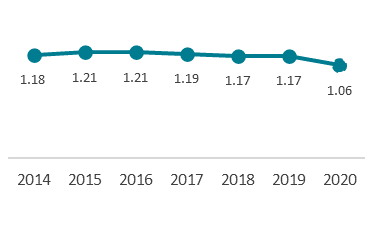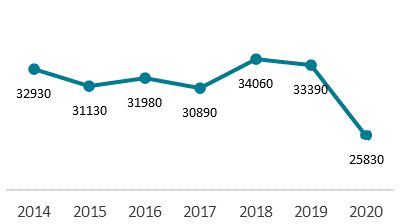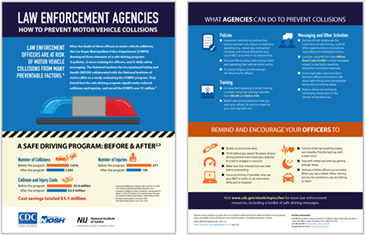Center for Motor Vehicle Safety
The Center for Motor Vehicle Safety (CMVS) conducts research and develops strategies to prevent work-related motor vehicle crashes and resulting injuries. The CMVS emphasizes these industry sectors: Oil and Gas Extraction (OGE); Public Safety; Transportation, Warehousing, and Utilities (TWU); and Wholesale and Retail Trade. The CMVS prioritizes motor vehicle safety for:
- Truck drivers.
- Drivers in other high-risk jobs (e.g., emergency medical services workers, firefighters, law enforcement officers, OGE workers).
- Drivers of light vehicles (passenger cars, SUVs, pickup trucks).
- Strengthen understanding of how risk factors contribute to work-related motor vehicle crashes and resulting injuries.
- Develop and evaluate the effectiveness of engineering and technology-based safety interventions.
- Evaluate the effectiveness of motor vehicle safety management programs and practices.
- Promote the adoption of evidence-based technologies and practices by employers, workers, and others.
- Published quarterly newsletter titled “Behind the Wheel at Work” on effective motor vehicle safety program elements (700+ page views).
- Published “CDC Features” articles on in-vehicle monitoring systems (650+ page views) and marijuana and driving (2,100+ page views), providing best practices on these topics for employers.
- Published review articles on research needs related to fatigue among OGE workers and TWU industries. Both articles identified issues with inadequate sleep and fatigue in these industries which can increase the risks for collisions and injuries.
- Published article on findings from lab simulation of a curve speed warning system for fire trucks. This study provided a comprehensive evaluation of an innovative warning technology to reduce the risk of fire truck rollover crashes.
- Published fact sheet on how to prevent motor vehicle collisions among law enforcement officers.
- Provided information via a SiriusXM radio interview on keeping workers safe from large trucks driving through highway work zones. On average, this show has an audience of hundreds of thousands of listeners.
- Develop new web pages on driver safety technologies and how to build an effective motor vehicle safety program.
- Publish interactive data visualization dashboard on fatal crashes and fatalities involving large trucks.
- Publish findings from analysis of work-related motor vehicle fatalities using data from the Census of Fatal Occupational Injuries (CFOI) and Fatality Analysis and Reporting System (FARS).
- Publish “CDC Features” articles on struck-by incidents, young drivers, and pedestrian safety.

Mention of any company or product does not constitute endorsement by the National Institute for Occupational Safety and Health, Centers for Disease Control and Prevention
The Center for Motor Vehicle Safety (CMVS) seeks to ensure that all workers exposed to road traffic hazards while on the job have protection from the risk of motor vehicle crashes and resulting injuries. This snapshot shows recent accomplishments and upcoming activities.

Source: Bureau of Labor Statistics, Census of Fatal
Occupational Injuries (CFOI), Current Population Survey (CPS)

*Crashes on public roadways, vehicle occupants only
Source: Bureau of Labor Statistics, Survey of Occupational Injuries and Illnesses (SOII)

To learn more, visit
www.cdc.gov/niosh/motorvehicle/
July 2022
